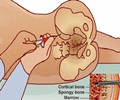Engineered, functional, accessory bone marrow holding donor cells, implanted under skin, removes need for host marrow irradiation prior to marrow transplant.
- Bone marrow transplant is a common procedure to treat marrow diseases such as aplastic anemia or immune destruction of the marrow.
- Pre-treatment of patient’s marrow by radiation before a transplant is associated with undesirable side effects.
- New lab designed bone marrow can be implanted beneath skin thus eliminating need for host marrow irradiation.
Accessory bone designed by bioengineering professor Shyni Varghese and her team at the UC San Diego Jacobs School of Engineering can be implanted under the skin where they have their unique space to grow without competition from host marrow cells, eliminating the need for the latter cells to be wiped out unnecessary. Aim of the Research
The aim of this research was to make bone marrow transplant safe and free from unwanted side effects for the patient.
The engineered marrow used in the study eliminated the need for such irradiation, making the transplant safer. "We've made an accessory bone that can separately accommodate donor cells. This way, we can keep the host cells and bypass irradiation," Varghese said.
Details And Results of the Current Research
- The research team developed an accessory bone similar to normal long bones in the body with an outer porous hydrogel matrix composed of calcium phosphate minerals and an inner marrow cavity.
- The engineered bone was filled with donor stem cells and implanted beneath the skin of mice.
- Stem cells in the outer matrix developed into mature bone cells with a vascular network. The inner marrow which held the donor stem cells grew and differentiated into blood cells in the host.
- Four weeks after the implant, the team found that the implanted marrow contained a mixture of donor and host cells confirming that donor stem cells and host cells traveled between the host bloodstream and the implanted marrow via the vascular network in the bony matrix.
- The same mixture of donor and host cells was found circulating in the bloodstream even 24 weeks after the procedure.
- The team of scientists also took stem cells form the implanted marrow and infused them into mice whose marrow had been destroyed by drugs or radiation.
- It was noted that the transplanted stem cells also reached the bloodstream of the host.
Scope of the Research
If further studies establish the safety and efficacy of engineered bone marrow implants, it could lead to safer and effective therapy for various bone marrow diseases. "In the future, our work could contribute to improved therapies for bone marrow disease," said Shih.
Future Research Plans
Source-Medindia
















